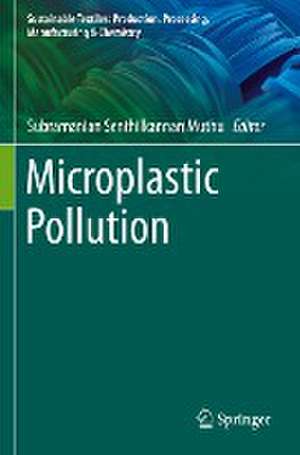Microplastic Pollution: Sustainable Textiles: Production, Processing, Manufacturing & Chemistry
Editat de Subramanian Senthilkannan Muthuen Limba Engleză Paperback – 16 mar 2022
| Toate formatele și edițiile | Preț | Express |
|---|---|---|
| Paperback (1) | 578.55 lei 43-57 zile | |
| Springer Nature Singapore – 16 mar 2022 | 578.55 lei 43-57 zile | |
| Hardback (1) | 727.48 lei 43-57 zile | |
| Springer Nature Singapore – 15 mar 2021 | 727.48 lei 43-57 zile |
Din seria Sustainable Textiles: Production, Processing, Manufacturing & Chemistry
- 24%
 Preț: 778.70 lei
Preț: 778.70 lei - 18%
 Preț: 726.37 lei
Preț: 726.37 lei - 17%
 Preț: 524.94 lei
Preț: 524.94 lei - 20%
 Preț: 692.84 lei
Preț: 692.84 lei - 18%
 Preț: 790.28 lei
Preț: 790.28 lei - 18%
 Preț: 1002.61 lei
Preț: 1002.61 lei - 18%
 Preț: 951.29 lei
Preț: 951.29 lei - 18%
 Preț: 781.62 lei
Preț: 781.62 lei - 18%
 Preț: 895.45 lei
Preț: 895.45 lei - 15%
 Preț: 583.93 lei
Preț: 583.93 lei - 15%
 Preț: 694.04 lei
Preț: 694.04 lei - 15%
 Preț: 637.46 lei
Preț: 637.46 lei - 15%
 Preț: 575.77 lei
Preț: 575.77 lei - 15%
 Preț: 576.09 lei
Preț: 576.09 lei - 15%
 Preț: 578.05 lei
Preț: 578.05 lei - 15%
 Preț: 581.33 lei
Preț: 581.33 lei - 15%
 Preț: 579.34 lei
Preț: 579.34 lei - 15%
 Preț: 701.72 lei
Preț: 701.72 lei - 15%
 Preț: 642.64 lei
Preț: 642.64 lei - 18%
 Preț: 948.79 lei
Preț: 948.79 lei - 15%
 Preț: 518.64 lei
Preț: 518.64 lei - 15%
 Preț: 696.68 lei
Preț: 696.68 lei
Preț: 578.55 lei
Preț vechi: 680.65 lei
-15% Nou
Puncte Express: 868
Preț estimativ în valută:
110.71€ • 115.88$ • 92.14£
110.71€ • 115.88$ • 92.14£
Carte tipărită la comandă
Livrare economică 31 martie-14 aprilie
Preluare comenzi: 021 569.72.76
Specificații
ISBN-13: 9789811602993
ISBN-10: 9811602999
Pagini: 174
Ilustrații: IX, 174 p. 28 illus., 25 illus. in color.
Dimensiuni: 155 x 235 mm
Greutate: 0.27 kg
Ediția:1st ed. 2021
Editura: Springer Nature Singapore
Colecția Springer
Seria Sustainable Textiles: Production, Processing, Manufacturing & Chemistry
Locul publicării:Singapore, Singapore
ISBN-10: 9811602999
Pagini: 174
Ilustrații: IX, 174 p. 28 illus., 25 illus. in color.
Dimensiuni: 155 x 235 mm
Greutate: 0.27 kg
Ediția:1st ed. 2021
Editura: Springer Nature Singapore
Colecția Springer
Seria Sustainable Textiles: Production, Processing, Manufacturing & Chemistry
Locul publicării:Singapore, Singapore
Cuprins
Effect Of Textile Parameters On Microfiber Shedding Properties Of Textiles.- Current State Of Microplastics Research In Saarc Countries – A Review.- Distribution And Impact Of Microplastics In The Aquatic Systems: A Review Of Ecotoxicological Effects On Biota.- Microplastics Pollution In Marine Environment: Occurrence, Fate And Effects (With A Specific Focus On Biogeochemical Carbon And Nitrogen Cycles.- Domestic Laundry And Microfiber Shedding Of Synthetic Textiles.- Microplastics In Dentistry- A Review.
Notă biografică
Dr. Subramanian Senthilkannan Muthu currently works for SgT Group as Head of Sustainability, and is based out of Hong Kong. He earned his PhD from The Hong Kong Polytechnic University, and is a renowned expert in the areas of Environmental Sustainability in Textiles & Clothing Supply Chain, Product Life Cycle Assessment (LCA), Ecological Footprint and Product Carbon Footprint Assessment (PCF) in various industrial sectors. He has five years of industrial experience in textile manufacturing, research and development and textile testing and over a decade's of experience in life cycle assessment (LCA), carbon and ecological footprints assessment of various consumer products. He has published more than 100 research publications, written numerous book chapters and authored/edited over 95 books in the areas of Carbon Footprint, Recycling, Environmental Assessment and Environmental Sustainability.
Textul de pe ultima copertă
This book addresses the emergent need to act on reducing or getting rid of micro plastic pollution, to achieve a sustainable environment. Microplastics are small plastic pieces, which are less than five millimeters long which can be harmful to our oceans and aquatic life. These predominantly include microfibers from clothing, microbeads, and plastic pellets. Microplastics impact aquatic creatures, turtles and birds. According to the first study on estimation of human ingestion of microplastic, on average a person consumes at least 50,000 particles of microplastic a year and breathes a similar quantity. Ingested microplastic particles can physically damage organs and also compromise immune function and stymie growth and reproduction. This book presents six informative chapters in order to alleviate the above mentioned issues.
Caracteristici
Highlights the emergent need for reducing and getting rid of microplastic pollution Includes an interesting chapter on domestic laundry and microfiber shedding of synthetic textiles Discusses microplastic pollution in Dentistry and in sediments with a focus on biogeochemical carbon and nitrogen cycles
